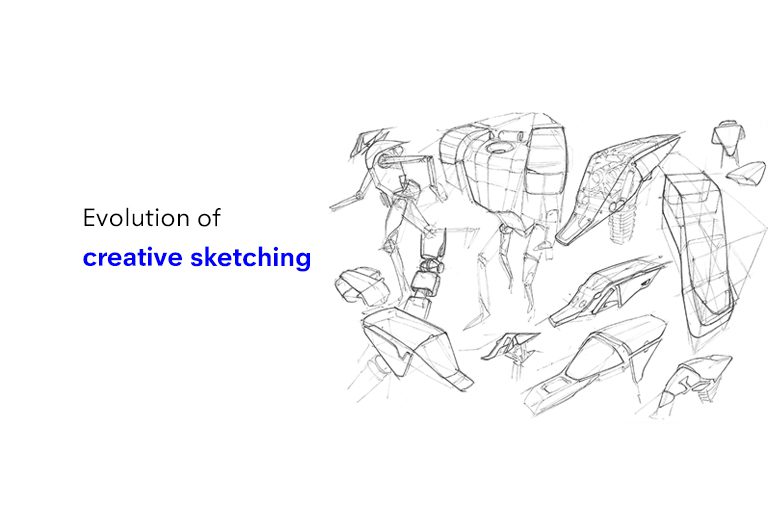For humans, sketching has been a way to represent and present the world around us and our creative ideas. It is known to be the starting point of many creative design processes where it can be then a rough drawing that represents itself as a draft or work as a description of an event, person or thing.
It is also known to be a powerful tool that initiates ideas to develop into products, offers observations and solutions to your design process. It is a way to put your creativity into action, bring ideas to the limelight and share a story with the world.
Sketching can serve a number of purposes:
- it can act as a tool in the design process to build on an idea,
- act as an art form for an artist – the sketch representing a message in itself, and,
- as a skill that can be further imparted to others, teaching prospects.
Also Read: A brand identity designer’s guide to responsive logo design
For example, a fashion designer might sketch the idea of a garment he/she wishes to sew without adding much detail will act as a tool to build on the idea while for Picasso – his sketch in itself is a form of art that speaks of a message and offers engagement opportunity to its viewers.
If we are to consider the role of sketching in our daily lives, or the traditional role of sketching for brands/ artists, it can be divided into the following categories –
- Sketching to understand – Understand existing things, people, situations, basically taking in inputs, observing keenly on a particular object and bringing details out.
- Sketching to communicate – Communicate details about a specific object or product, in simpler words – a sketch that is informative and builds awareness.
- Sketching to create – Create original concept, new idea, a rather vague and more loose sketch of something to build on eventually.
In the design world, creative sketching is an essential part of the ideation process. Part of the early stages of the design process, sketching is part of the visual communication language of any brand and the role of sketching here is to facilitate ideas and explore designs. From pen/pencil on paper/ canvas to digital sketching using design tablets and technology baked applications, the way we sketch today has changed leaps and bounds. This evolution is no doubt fueled by technological advancements that have helped make our 2D sketches into 3-D objects.
Today digital sketching has become part of a designer’s everyday life. There are digital sketching tools that have been built to support and augment the sketching process. These tools offer a number of functions to designers to explore different alternatives, suggest new ideas and share digital sketches while facilitating creativity.
Also Read: Applications of Color Theory By Top Brands
Here is a brief look into the history of sketching and its evolution to digital mediums:
Caves and structures
A physical product and its visual communication are linked for eons together with one word – sketching. From the early cave paintings to the detailed monarchical strong architectural design – sketching has aided in communicating an era, a product while building from these inspirations brand new products and ways to communicate. We today have proof that cavemen communicated via sketches inside the caves, drawing them as a form of understanding each other and reflecting how sketching was their language of interaction.
Pen and Paper
Our minds tend to go straight to a paper with pencil / pen in our hand when someone says the word sketch. From papyrus, to etching to pencil and now sketchpads – this is one unchanged part of sketching that is still an essential in design school across the globe.
-Sketching as a mediator and skill
During the renaissance period and middle ages, it is known that sketching was the primary mediator between the idea and the finished product – produced by a master craftsman in sculpting, painting or architecture. During these days, such master craftsmen would teach their assistants on how to sketch as a starting point of their journey to become master craftsmen.
-Sketching to understand
It is well known that Leonardo Da Vinci got many draftsmen to sketch a large number of ( over 200) figures from human anatomy. His interests ranged from science to technology. He used the camera obscura to project an image onto a flat surface and the draftsman would help trace over the image. Making the use of sketch here as part of understanding and observing the world around us.
Also Read: What UX/UI and emerging technologies can do for the retail industry?
Software’s and hardware’s
From pen and paper to Adobe suits and design tablets – the world came a long way. 1988, the world saw the beginning of a new year with an image -editing program launched. Today, we can hardly imagine our lives without Adobe Photoshop, Illustrator or the multiple other software’s available in the market. These software’s have multiple tools that enhance the process of sketching and offer it more on the lines of a creative tool or as an art form.
In 1984, Wacom launched its first cordless pen with tablet that enabled designers to draw with ease on the tablet. Their aim was to offer a unique product that is exclusive to the design community, ideally disrupting the way design has been known. Wacom to this date is known to be the first choice of many designers and artists across the globe.
With the introduction of these innovations in the design sector and their rapid development over time, these brands have successfully offered to put into a device every tool used in graphic design, illustration and fine arts into one product. Not just that, they also have built unique features that are physically impossible during sketching.
These disruptive innovations have moved the nature of sketching from simply being a beginning process of an idea to an actual form of art that is globally acknowledged and also as a creative outlet and tool.
Also Read: How rapid prototyping is transforming the automotive industry
Physical drawing on digital surface
In 2011,the Procreate application was launched on iPad. Aimed to build and recreate the natural feeling of when we draw physically, while being able to utilize all the unique tools of digital platforms. Essentially a graphic editor app built for painting, Procreate is a complete art studio at the touch of your hands, easy to carry anywhere and is now built with intuitive creative tools to help you sketch your idea/ observation and to communicate a story.
It is also known that James Jeans, an artist has used Procreate to ideate3 and draw film posters and David Hockney, well-known english painter, has also used Procreate to create a series of landscape paintings.
2D to 3D and Emerging Technology
From sketching and viewing them in two-dimension to sketching and viewing ideas in three- dimensional space. Take in all the previous tools, hardware’s and application and then mix it with the latest emerging tech. This will give you design platforms like Gravity Sketch that are 3-D and intuitive, offering collaborative design sketching processes in real time. With the help of Virtual reality technology, platforms like Gravity Sketch offer a 3D BR space to help your sketching with a sense of depth and perspective similar to that of our surroundings. There is now a possibility to scale, add depth and know the physicality to our sketches – what was earlier missing in 2D designs. This helps in evolving the kinesthetic experience of sketching.
Each era in their own way has been able to innovate and evolve the process of sketching while empowering the creator and giving them the best possible tools.
Also Read: Innovative product design ideas that impacted the world
At Strate Design School, Bangalore – creative sketching is an essential component in your design learning process with emphasis paid on it being all three, a tool, an art form and a skill. You will not only learn to observe how sketches help define objects, but also brainstorm and ideate to build new and original concepts. Get more information on the courses here.



Want to Become a Designer ?
Strate is a unique design school that nurtures your talents as a designer by offering state-of-the art designing courses in Bangalore.
Join Strate